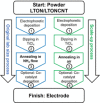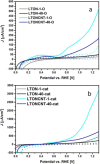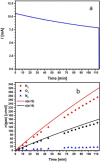Scaling Up Electrodes for Photoelectrochemical Water Splitting: Fabrication Process and Performance of 40 cm2 LaTiO2 N Photoanodes
- PMID: 30600935
- PMCID: PMC6680292
- DOI: 10.1002/cssc.201802645
Scaling Up Electrodes for Photoelectrochemical Water Splitting: Fabrication Process and Performance of 40 cm2 LaTiO2 N Photoanodes
Abstract
A scalable process for fabrication of particle-based photoanodes is developed. The electrodes are versatilely made of photocatalytically active semiconductor particles, in this case LaTiO2 N, and optionally coated with cocatalysts and protecting components, all immobilized on a conducting substrate. The involved fabrication steps are restricted to scalable processes such as electrophoretic deposition, annealing in air, and dip coating. Special care is taken to ensure efficient charge transport in-between particles and to the substrate by incorporating conducting connectors. By adapting the fabrication steps, the electrode geometrical dimension is increased from the size of a typical lab electrode of 1 to 40 cm2 . The quality of the scale-up process is characterized by comparing the photoanodes in terms of thickness, light-absorption properties, and morphology. For several compositions, the electrochemical performance of both electrode sizes is assessed by measuring the photocurrents and faradaic efficiencies. The comparison revealed a complex upscaling behavior and showed that the photoelectrode size affects performance already on the 0.1 m scale.
Keywords: LaTiO2N; electrode area; energy conversion; photocurrent; water splitting.
© 2019 The Authors. Published by Wiley-VCH Verlag GmbH & Co. KGaA.
Conflict of interest statement
Figures






Similar articles
-
Design Guidelines for High-Performance Particle-Based Photoanodes for Water Splitting: Lanthanum Titanium Oxynitride as a Model.ChemSusChem. 2015 Oct 26;8(20):3451-8. doi: 10.1002/cssc.201500830. Epub 2015 Sep 11. ChemSusChem. 2015. PMID: 26360811
-
Solution-processed nickel oxide passivation on large-area silicon electrodes for efficient photoelectrochemical water splitting.RSC Adv. 2024 Dec 23;14(54):40180-40186. doi: 10.1039/d4ra06774f. eCollection 2024 Dec 17. RSC Adv. 2024. PMID: 39717806 Free PMC article.
-
Highly Efficient Water Oxidation Photoanode Made of Surface Modified LaTiO2 N Particles.Small. 2016 Oct;12(39):5468-5476. doi: 10.1002/smll.201601929. Epub 2016 Aug 24. Small. 2016. PMID: 27555609
-
Toward High-Performance Hematite Nanotube Photoanodes: Charge-Transfer Engineering at Heterointerfaces.ACS Appl Mater Interfaces. 2016 Sep 14;8(36):23793-800. doi: 10.1021/acsami.6b05366. Epub 2016 Aug 29. ACS Appl Mater Interfaces. 2016. PMID: 27551887
-
Solar water splitting: progress using hematite (α-Fe(2) O(3) ) photoelectrodes.ChemSusChem. 2011 Apr 18;4(4):432-49. doi: 10.1002/cssc.201000416. Epub 2011 Mar 17. ChemSusChem. 2011. PMID: 21416621 Review.
Cited by
-
Efficient Electrochemical Reforming of Water-Insoluble C‑Only Plastic Wastes.ACS Sustain Chem Eng. 2025 May 27;13(22):8289-8297. doi: 10.1021/acssuschemeng.5c00907. eCollection 2025 Jun 9. ACS Sustain Chem Eng. 2025. PMID: 40510916 Free PMC article.
-
Recent Research Progresses and Challenges for Practical Application of Large-Scale Solar Hydrogen Production.Molecules. 2024 Dec 20;29(24):6003. doi: 10.3390/molecules29246003. Molecules. 2024. PMID: 39770092 Free PMC article. Review.
-
Stability and degradation of (oxy)nitride photocatalysts for solar water splitting.RSC Sustain. 2024 May 2;2(6):1738-1752. doi: 10.1039/d4su00096j. eCollection 2024 Jun 5. RSC Sustain. 2024. PMID: 38845685 Free PMC article. Review.
-
Lead-Free Metal Halide Double Perovskite-Photoelectrocatalyzed Activation of C(sp3)‑H Bonds and Alkylation of Alkenes and Azo Compounds.JACS Au. 2025 Jun 16;5(7):3189-3202. doi: 10.1021/jacsau.5c00366. eCollection 2025 Jul 28. JACS Au. 2025. PMID: 40747046 Free PMC article.
References
-
- None
-
- Pinaud B. A., Benck J. D., Seitz L. C., Forman A. J., Chen Z. B., Deutsch T. G., James B. D., Baum K. N., Baum G. N., Ardo S., Wang H. L., Miller E., Jaramillo T. F., Energy Environ. Sci. 2013, 6, 1983–2002;
-
- Shaner M. R., Atwater H. A., Lewis N. S., McFarland E. W., Energy Environ. Sci. 2016, 9, 2354–2371.
-
- None
Grants and funding
LinkOut - more resources
Full Text Sources
Miscellaneous

